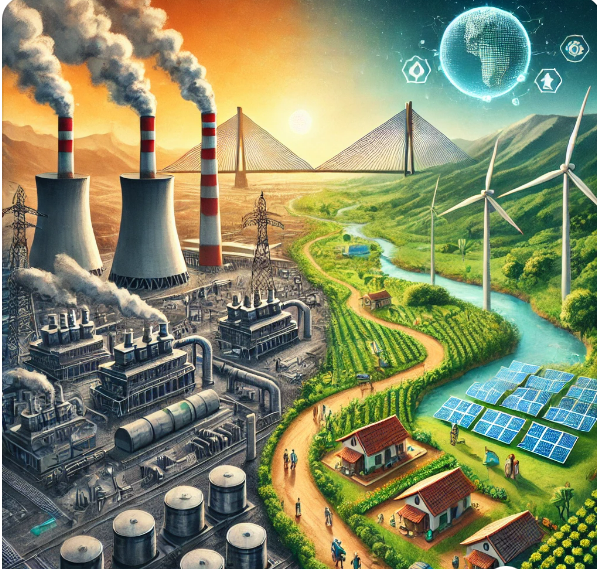Reimagining Just Energy Transition: India’s Case Study
ENERGY FOR SUSTAINABILITY
10/22/20246 min read


The Economy Council


PIC: ChatGPT
As the world teeters on the edge of a climate crisis, a just energy transition has become more than necessary—an ethical imperative. Yet, the road to this transition is not straightforward, especially for nations like India, where coal is not just an energy source but an economic lifeline for millions. The existing global narrative of phasing out coal doesn’t accommodate the complex realities that countries like India face. For a just transition away from coal, India will require over $1 trillion (Rs 84 lakh crore) over the next 30 years, according to a study by the think tank iForest (International Forum for Environment, Sustainability, and Technology). This staggering financial requirement reflects India's multifaceted challenge in transforming its coal-based economy without devastating communities that depend on it.
What is missing is a radical rethinking—a vision that redefines the very principles of transition. India needs a transformative, homegrown model that not only addresses its unique challenges but also sets an example for the world.
This new roadmap should not be just about energy but about building a new socio-economic order—one that lifts communities, fosters innovation, and embraces coal as part of the solution, not the enemy.
Breaking Free from the Binary: Coal as a Catalyst, Not a Crutch
The prevalent idea that coal is purely a problem to be eliminated is both shortsighted and counterproductive. Instead of treating coal like a relic of the past, we must rethink it as a bridge to a greener future. This is not about delaying the inevitable but strategically leveraging coal in a manner that aligns with India's growth and environmental goals.
Integrated Dual-Use Coal Plants: Imagine existing coal plants not as monoliths to be shut down, but as dual-use facilities where clean energy technologies like solar thermal, hydrogen production, or energy storage systems can be seamlessly integrated alongside coal-based power generation. Instead of shutting coal plants outright, India could retrofit them, repurposing excess heat or energy to power new green technologies. This approach would extend the utility of current infrastructure while reducing emissions.
Carbon as Currency: What if carbon emissions themselves became a valuable resource? India could pioneer a system where captured carbon from coal plants is used to fuel a new wave of industrial innovation—whether through carbon credits that finance renewable projects or by utilizing CO₂ in manufacturing industries such as carbon-infused building materials, plastics, or synthetic fuels. Carbon, then, becomes a currency, not a curse, creating value while decarbonizing the economy.
This novel approach turns coal from being part of the problem into a critical asset in a multi-faceted energy future. It aligns with India’s unique circumstances and offers a more realistic transition path.
Local Empowerment as the Core of Transition: Energy Democracy in Action
India’s energy transition must be about empowering local communities, not just substituting one energy source for another. For coal-dependent regions, the fear of economic devastation is real. But what if the future was about energy democracy—the ability of communities to own, control, and profit from the new green economy?
Coal Miners as Clean Energy Entrepreneurs: Instead of training former coal workers merely to be employees in solar farms or wind plants, why not transform them into energy entrepreneurs? With the right financial models and skill training, former miners could own stakes in new renewable energy projects. They could establish community solar cooperatives or micro-wind grids, where profits are shared among local families. This energy ownership model would replace dependency on external forces with local autonomy, ensuring that the transition is not just equitable but empowering.
Green Bonds for Local Investment: India’s government, in collaboration with international partners, could issue "Green Development Bonds" directly targeted at coal-dependent districts. These bonds would pool global climate finance with local investments, allowing communities to reinvest in renewable infrastructure, local businesses, and clean technology start-ups. Instead of waiting for trickle-down benefits, local areas could take charge of their futures, turning former coal towns into vibrant centers of green innovation.
This is a shift from the top-down approach to grassroots-led economic regeneration—a vision where energy transition doesn't just happen to people but is driven by them.
Turning India into the World’s Clean Energy Lab
India’s challenge is also its greatest opportunity: it can become the world’s laboratory for next-generation energy solutions. While developed nations are constrained by their established energy systems, India, with its growing energy demand and diverse energy needs, can leapfrog into a post-coal world with cutting-edge, scalable technologies.
India’s Smart-Grid Revolution: Instead of following the conventional path of centralized grid systems, India could pioneer smart, decentralized energy grids tailored to urban, rural, and industrial zones. These grids would incorporate AI-driven energy management, enabling real-time balancing of supply and demand across a patchwork of renewable sources. Blockchain-based energy trading could allow households, businesses, and even local governments to buy and sell surplus energy locally, reducing reliance on large utilities and empowering consumers.
Hydrogen and Beyond: India has an untapped potential to become a global leader in green hydrogen production. Leveraging its abundant renewable resources, India could focus on producing hydrogen for domestic industrial use, transportation, and eventually for export. If India cracks the cost-competitive hydrogen economy, it could create an entirely new industry that doesn’t just replace coal but surpasses it in global economic value. Hydrogen could be to 21st-century India what coal was to 19th-century Britain—a pillar of industrial strength.
Green Jobs 3.0: Beyond simply creating jobs in wind or solar installation, India should focus on creating a clean-tech manufacturing ecosystem—designing, manufacturing, and exporting components like solar panels, wind turbines, batteries, and hydrogen electrolyzers. This would make India the industrial backbone of the global clean energy revolution, much like how China became the world’s factory. An India-led clean tech industrial base could not only meet domestic needs but also capture emerging markets in Africa, Southeast Asia, and Latin America.
This vision propels India beyond being a follower in the global transition; it positions India as the leader of a new industrial revolution.
Have You Read:
Who We Are:
The Economic Nations champions global unity through economic collaboration, focusing on sustainable growth, reducing inequalities, and enhancing global relationships for mutual prosperity and peace.
______________________________________
PIC:Canva
Time for a Global Energy Compact: Realigning the Paris Agreement
India’s challenges are not unique—they are shared by other developing nations that find themselves trapped between the need for development and the pressures of climate change. The current frameworks like the Paris Agreement do not sufficiently address the vast disparities in historical emissions or economic capabilities. What India needs is a new, global energy compact—a reimagined international accord that shifts the burden of responsibility onto developed nations without penalizing emerging economies.
Global Energy Reparation Fund: Instead of the current fragmented climate finance models, the world needs a Global Energy Reparation Fund. This fund would be financed primarily by historical polluters, who would be mandated to contribute based on their cumulative emissions over the past century. The fund would focus not only on renewable energy investments but also on retraining programs, social safety nets, and community-building efforts in coal-dependent regions. This would signal a genuine shift from empty promises of aid to real, binding commitments that reflect the scale of the challenge.
Technology Transfer as Climate Equity: The new compact would also formalize technology transfer as a key element of climate equity. Developed nations would be required to open-source key clean technologies to developing countries like India, waiving intellectual property barriers and expediting adoption. This would include the rapid dissemination of innovations in battery technology, carbon capture, smart grids, and hydrogen. No longer should climate technologies be monopolized by a few wealthy nations; they must be democratized for the global good.
At COP29 in Baku, the world is set to issue its first set of recommendations on how to build an enabling environment to unlock the $85 trillion opportunity estimated by the IMF from phasing out coal by 1.5°C-aligned timelines. This is more than a financial figure—it is the price of a sustainable future. Ministers from the G7 have also agreed to phase out unabated coal power plants by 2035, although they left the door open for countries heavily reliant on coal to breach the deadline if necessary. Such flexibility underscores the need for a tailored approach to coal transition, especially for countries like India.
Conclusion: A Vision for India and the World
India stands at the crossroads of a transition that will define not just its future but the future of energy systems globally. The time has come to abandon outdated models of energy transition that frame coal as the antagonist and replace them with bold, integrated solutions that reflect the complexity of India’s needs and ambitions. Coal should not be viewed solely as a resource to phase out but as a platform to build upon—through carbon utilization, technology integration, and localized empowerment. The road ahead is not a linear path to renewable energy, but a dynamic, multifaceted revolution that will reshape industries, communities, and global energy systems.
India, with its vast human capital, technical expertise, and economic potential, is not merely a passive participant in the global energy transition. It is the architect of a new paradigm, a leader in energy democracy, and the laboratory for the future of clean energy. This vision does not just reflect India's aspirations but offers the world a new, bold template for navigating the climate crisis with equity, creativity, and courage.
The transition begins now, and it will be India’s energy revolution that sets the world aflame—this time with hope, not coal.
Contacts
enquiry@economicnations.org
(xx) 98-11-937-xxx (On verification)
